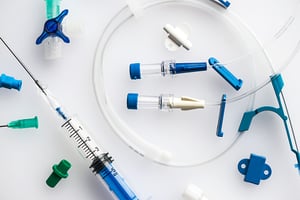What You Should Know if You Have a Hemodialysis Catheter
A Central Venous Catheter (CVC) is a soft flexible tube that is placed into a large vein, usually in the chest. It has two openings or ports. During hemodialysis, the ports are connected to the hemodialysis machine; one to take blood from your body to be cleaned, and the other to return blood cleaned of its impurities back to the body. A CVC is often  used while a patient is awaiting surgery to have an arteriovenous fistula or graft placed to be used as a permanent vascular access. Although not optimal, a CVC can also be used as a permanent vascular access.
used while a patient is awaiting surgery to have an arteriovenous fistula or graft placed to be used as a permanent vascular access. Although not optimal, a CVC can also be used as a permanent vascular access.
There are two types of CVCs, tunneled and non-tunneled. Tunneled CVCs are inserted under X-Ray for long-term use while non-tunneled CVCs are used short term and are usually located in your neck.
What You Should Do with a CVC
- Keep the dressing in place and dry at all times.
- To reduce the risk of germs entering the bloodstream, don’t breathe or cough over your CVC during dressing changes and when the CVC is being connected/disconnected.
- Avoid using sharp objects (such as scissors or shaving equipment) near your CVC.
- Never open the clamps or remove the end caps from the ports to prevent air and germs from entering the blood stream.
- Don’t pull on the CVC.
Only specially trained dialysis staff should do anything with your CVC, except in an emergency. At the end of each hemodialysis, a substance called a “line lock” which will prevent infection and clotting is inserted by the dialysis nurse into the CVC port.
Seek medical advice/help if any of the following occur:
- The dressing becomes wet or displaced, exposing the exit site.
- If a CVC falls out, apply pressure immediately to stop any bleeding.
- If a CVC dislodges, but doesn’t fall out completely, do not attempt to push it back in as this could introduce infection or go into the wrong blood vessel.
- If bleeding occurs from around exit site, apply pressure to exit site, and seek medical help.
- If the caps come off and clamps break at the same time, or if the tubing becomes cut or punctured between the clamp and the skin, nip the tubing between the broken clamp or punctured/cut tubing and the skin to prevent air from entering the bloodstream and seek medical help immediately. To help prevent damage caused by air entering the bloodstream, lie on your left-hand side with your feet up and head down until help arrives.
- Fevers, chills, sweats, painful, red or swollen exit site, generally unwell, discharge from exit site could indicate an infection and must be treated urgently.
Reference: https://britishrenal.org/; distilled from PatientInformationLeafletCVCFinal.pdf




